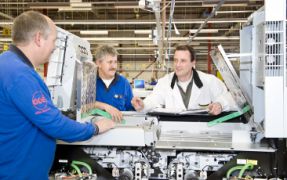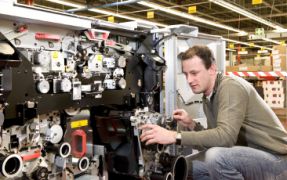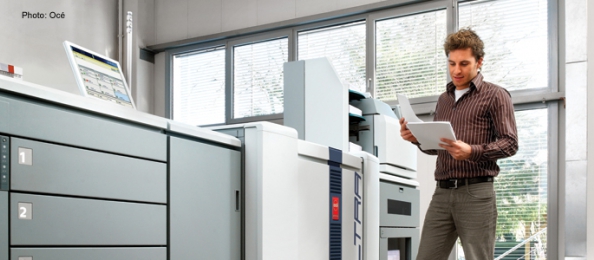Caring by Nature
Océ has a long history of environmental awareness. The company was founded in 1877 in the south of the Netherlands by a chemist called Lodewijk van der Grinten, who invented a completely natural coloring agent for margarine so that everyone, not just the well-off, could enjoy something healthy and appetizing on their bread. Earlier that same year, Mr. van der Grinten had investigated the quality of drinking water at the pumps in the town where he lived and the quality of the flour used by local bakers for the local health authority. These innovative practices have been handed down throughout the history of Océ: This commitment to environmental and social responsibility that the Océ founding fathers demonstrated in the mid-19th century is just as strong today.
Océ is focused on creating value for all stakeholders by realizing profitable, sustainable growth. The Océ strategy aims to optimize business processes, strengthen its product portfolio, and boost distribution power. Sustainability underpins these strategic aims. A strong performance in sustainability contributes to efficiency, stronger product propositions, and provides a powerful market image. It is no coincidence that Océ embraced sustainability as part of its core proposition decades ago.
Contemporary commitments to people and the environment
Since 2002 Océ has subscribed to the Global Compact of the United Nations. Océ addresses the principles of the UN Global Compact continuously in both its product development and its own operations.
In 2009, Océ made progress in each of the Global Compact stipulated areas by joining the Electronic Industry Citizenship Coalition (EICC). The EICC promotes an industry Code of Conduct for global electronics supply chains to improve working and environmental conditions. This Code of Conduct outlines standards that ensure working conditions in the electronics industry supply-chain are safe, workers are treated with respect and dignity, and that manufacturing processes are environmentally responsible. The UN Global Compact Principles were instrumental in the preparation of the EICC Code of Conduct.

Photo: Océ
Océ is committed to progressively aligning itself with the provisions of the EICC Code of Conduct. In order to encourage and support first-tier suppliers to also become aligned with the Code of Conduct provisions, Océ sent its suppliers a Supplier Declaration on the EICC Code of Conduct and invited them to show their commitment to the EICC by signing. The three principal Océ manufacturing sites in Venlo (Netherlands), Poing (Germany), and Vancouver (Canada) included their major suppliers, thereby covering 78 percent of their total supply base expenditure. By the end of 2009, half of the addressed suppliers returned a signed declaration. This translated into 47 percent of the total supply base expenditure of Océ being aligned with the EICC Code of Conduct.
Maximizing reuse
Operating in a sustainable way is embedded in Océ’s way of working. The ability to reuse materials, particularly in the manufacturing sector, is an integral part of sustainability. Not only does reuse save precious resources, it also minimizes landfill waste.
Océ products are typically built for long, intensive use under difficult circumstances. Designers at Océ develop products with a total lifecycle in mind. When a lease period for a machine (often between three to five years) comes to an end, a machine does not end up on the scrapheap, but its parts are refurbished and readied for reuse. Parts and modules are not type-specific and are designed to be used in a broad range of different printing systems.
Used machine parts from customers are recovered in special remanufacturing facilities, creating a constant stream of parts and units. These components are suitable for reuse as service parts and in new machines. Complete machines can also be refurbished and returned to market. In 2008 the company launched a series of remanufactured machines under the Océ Prémia Class label. In 2009 the popular Océ Prémia Class program was enhanced with the addition of new models. These remanufactured machines are equipped with new and popular functionalities that use fewer materials and less energy, which reduces carbon emissions during the production processes. An Océ study in 2009 revealed that the CO2 footprint for producing a remanufactured system is almost half that of a newly-produced system.
In 2008 Océ set a corporate target on the reuse of materials: “By 2010 the amount of reused parts in Océ-developed products will be more than 20 percent.” In 2009 the total use of materials for Océ-developed products amounted to 4.6 kilotons – 21 percent of which consisted of reused materials. This means Océ reached its target ahead of schedule. Additionally, Océ supplied approximately 12,000 refurbished service parts (150 tons) to customers. The increase in reuse is a result of optimizing Océ’s remanufacturing activities. In 2010 this will be continued by shifting several local remanufacturing activities, such as workshops, to centralized asset-recovery facilities.

Intrinsic values
Building an ever evolving sustainable business has always been one of the core business principles of Océ. We do this by developing products and services that add value to the document processes of our customers while minimizing environmental impact. And we conduct our business activities in a socially responsible manner aimed at preventing health, safety, and environmental risks. These philosophies are truly part of the DNA of the company, as they were already practiced when Océ was founded in 1877. Sustainability has been a driving force throughout the years – and will continue to be so, going forward.
About Océ
Océ is one of the world’s leading providers of document management and printing for professionals. The broad Océ offering includes office printing and copying systems, high-speed digital production printers, and wide-format printing systems for both technical documentation and color display graphics. Océ is also a foremost supplier of document-management outsourcing. Many of the world’s Fortune 500 companies and leading commercial printers are Océ customers. The company was founded in 1877. With headquarters in Venlo, the Netherlands, Océ is active in about 100 countries and employs some 22,000 people worldwide. Total revenues in 2009 amounted to €2.6 billion.
This project description was originally presented in the Global Compact International Yearbook 2010.
Sandra David works for Oce.
About Us // Privacy Policy // Copyright Information // Legal Disclaimer // Contact
Copyright © 2012-2018 macondo publishing GmbH. All rights reserved.
The CSR Academy is an independent learning platform of the macondo publishing group.









